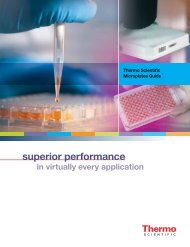PeloBiotech
You also want an ePaper? Increase the reach of your titles
YUMPU automatically turns print PDFs into web optimized ePapers that Google loves.
www.pelobiotech.com<br />
Applications:<br />
The integration of microfluidic systems with 3D cell cultures has enabled<br />
the study of angiogenesis, microcirculation, and vascular functions with<br />
high precision and control. These models have facilitated the elucidation<br />
of the roles of the microvasculature in health and disease, particularly in<br />
the context of angiogenesis and thrombosis.<br />
Microfluidic devices have been instrumental in culturing 3D cells under<br />
dynamic conditions, providing a platform for high-throughput drug<br />
testing on cancer spheroid models. The successful commercial application<br />
of 3D hepatocyte in vitro models for drug testing has been linked to the<br />
development of hepatocyte-supporting 3D microenvironments in<br />
microfluidic channels. Microfluidic platforms incorporated with 3D<br />
microscaffolds and submicron/nanoscale topographies have shown<br />
promise for 3D cell cultures, offering a potential model for various<br />
applications.<br />
Microfluidics has enabled dynamical screens with precise control over the<br />
concentration, timing, and duration of fluidic delivery, particularly in the<br />
context of drug screening on tumor organoids. By leveraging the small<br />
dimensions and laminar flow inherent in microfluidic systems, in vitro<br />
models have been developed to reproduce many features of the in vivo<br />
vascular microenvironment with fine spatial and temporal resolution.<br />
These models have provided valuable insights into the dynamics of singlecell<br />
immune responses and have facilitated the quantification of immune<br />
dynamics at a high content level. Furthermore, microscale in vitro<br />
physiological models of the liver have been developed using microfluidic<br />
systems, enabling predictive screens for drug metabolism, enzyme<br />
induction, and assessment of acute and chronic liver toxicity arising from<br />
exposure to drugs or environmental agents.<br />
MCF7 cells are seeded into LiveBox 1<br />
Multiorganoid testing with multiple chambers,<br />
(pics: IVTech)<br />
Physiological Models:<br />
• Cornea<br />
• Liver<br />
• BBB<br />
• Intestinal Organoids<br />
• Upper Bronchial Tubes<br />
Disease Models:<br />
• Rare disease: test of a novel approach<br />
• Breast Cancer<br />
• Diabetes Treatment i.e. Langerhans - islet<br />
transp.<br />
Multi Organ Model:<br />
• Study of Crosstalk between<br />
normal and cancer tissues<br />
58
















